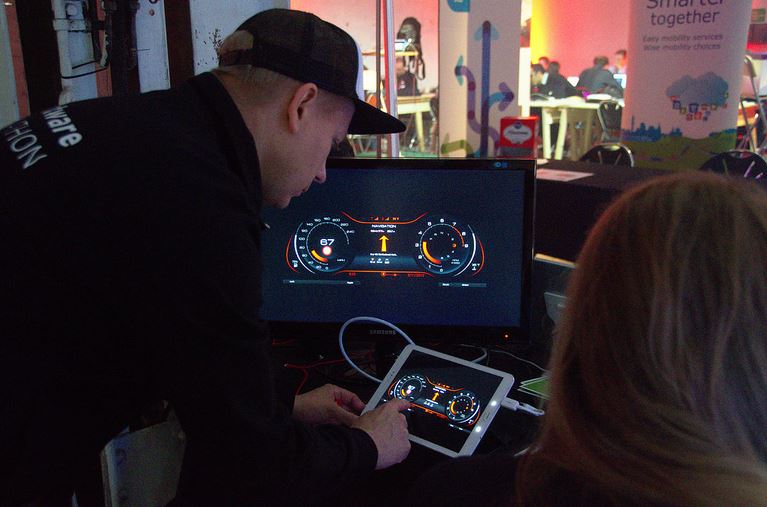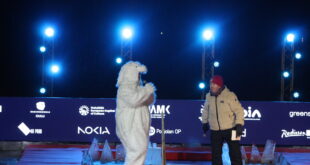Mobile phones have changed the way people experience the world. People daily use digital interfaces, as software has become integrated into the products we use in our lives and work.
By extension, people now have certain expectations for a UI (user interface), where the interaction between humans and machines occurs.
But how does this affect the traditional industries?
Olli Laiho of Rightware has som e ideas. Rightware provides digital user interface software for the automotive industry, and currently have about 20 million cars underway containing their products. As a partner of Ultrahack, part of Slush Hacks, Rightware hopes to inspire more entrepreneurs to look into disrupting traditional industries.
e ideas. Rightware provides digital user interface software for the automotive industry, and currently have about 20 million cars underway containing their products. As a partner of Ultrahack, part of Slush Hacks, Rightware hopes to inspire more entrepreneurs to look into disrupting traditional industries.
As Olli explains, the automobile industry is only one of many traditional industries being disrupted. “We are also seeing disruption in medical and industrial industries, because those consumers use mobile devices in their private life.”
How is the automotive industry being disrupted?
Cars themselves have their own “UI” – the physical gauges on a car that help you track your mileage, speed, and fuel consumption, and UI’s not related to the mechanics of the automobile, such as radios and GPS.
However, these “traditional” UIs are becoming more and more obsolete, as the use of mobile phones and the consumption of digital media increase.
As Olli explains, “You might have lately seen info-tainment screens in cars that have some apps, some UI to it, but you probably don’t need to use it because your phone can do it so much better…it’s a watered-down version of your cell phone.”
With new technologies like the Apple Carplay and Android Auto, Google and Apple have made their way into our cars, and replaced certain elements in a vehicle with their own software.
“Now, this is still a small part of the car, but nevertheless, these products have made their way into the car, because consumers demand it.”
As expectations for UI have risen so dramatically, these sorts of designs are now expected in the cockpit.
“UI will become a key element in cars, and the amount of screens will only keep on growing.”
Waking up to the possibilities of UI
As Olli says, the automobile industry is finally waking up to the possibilities of UI, and moreover, beginning to differentiate the UI in an automobile from a mobile UI, for a better overall user experience within the car.
“It is a very traditional industry, so change happens slowly, but we’re seeing disruptions happen, and they do happen, and they do have an effect, so we are seeing a trend of hiring more digital UX specialists, who are thinking about the digital experience as a whole, and really thinking about this more and more as a digital products.”
“Your design director who previously worked in plastics, metals, chromes, and leather, now has to work with digital services.”
The ultra-personalized experience
So how will automobile UIs catch up to mobile phones, and supersede them as our UI of choice in our cars? Olli predicts two things: HUD’s (Head-up Displays) and ultra-personalization.
With HUD’s, cars will be able to show drivers data in a safe, streamlined way, that enhances their ability to drive rather than hindering their concentration.
“It’s a design challenge right now, as the graphics you have are very simple. You really need just the right data at just the right time.”
And what sort of data will HUD’s show? Olli believes the consumer demand for personalized data, and thus personalization of experience, will be a driving force for auto UIs. Solving the problems of flow and access to data is the next big hurdle.
“We are seeing more and more user data flowing into all the screens in the car – you will even have your personal data behind the wheel, like your messages or personal preferences.”
And by personal preferences, he means more than just the radio stations you like to listen to.
“When you go in the car and have your key, the car will actually recognize that it’s you, fetch your data from the cloud, show your next meeting destination, and take you there.”
“I think the personalization will also be something that can help with customization where you can choose from a set of different themes that best suit your taste. The sky’s the limit — let’s see what companies will come up with.”
Why the Nordic are poised to succeed
It is self-evident that as technology comes into our cars, there is more need for UI in cars. But why has Rightware, a Finnish company whose key employees come from the gaming industry, gotten their software into so many cars?
Olli says that their strength came from their backgrounds as Nordic game developers in particular.
“With gaming, you are dealing with accelerated graphics.” When they set up the company in 2009, the software they were building was highly design-oriented, which made for a competitive product.
“The Scandinavian design has a huge benefit – clean, fresh designs, innovative…and we are able to quickly iterate. We are agile,” says Olli.
He is optimistic about Scandinavian companies dominating in this niche, as they have a strong pool of technical talent and a streamlined design sensitivity that is appealing to auto manufacturers.
“Car companies have become software companies. They need digital UX to stay competitive. There is a rapidly growing need for artists, technical people, designers, and software engineers.”
Most importantly, who you are and where you come from matters little when it comes to designing top software.
“When you are dealing digitally, you can go outside borders,” says Olli.
Ultrahack, part of Slush Hacks is held on 6th through 8th of November in Helsinki, Finland. Read more at ultrahack.org.
Slush is the biggest startup and investor event in Northern Europe, organized on November 11-12th in Helsinki, Finland. Read more about the event at slush.org.
 Nordic Startup News Early Stage Startup News From The Nordics
Nordic Startup News Early Stage Startup News From The Nordics


